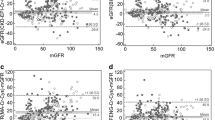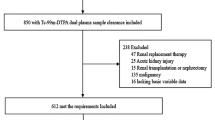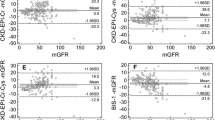Abstract
Background
This study aimed to further evaluate the accuracy of eleven GFR equations in different subgroups of an elderly Chinese hospitalized population.
Methods
All participants of the study were divided into seven separate groups including age-subgroup, sex-subgroup, GFR Staging-subgroup and whether combined with diabetic, hypertensive, coronary heart disease (CHD) and cerebrovascular disease. Referring to Tc-99m-DTPA dual plasma sample clearance method, six serum creatinine (Cr)-based [Cockcroft–Gault (CG), Chronic Kidney Disease Epidemiology Collaboration (CKD-EPICr), Lund-Malmö Revised (LMR), Berlin Initiative Study (BIS1), Full Age Spectrum (FASCr) and European Kidney Function Consortium (EKFC)], two serum cystatin C(Cys)-based (CKD-EPICys and FASCys), and three Cr-Cys combination based (CKD-EPICr-Cys, BIS2 and FASCr-Cys) equations were employed. Bias, interquartile range of the median difference (IQR), P30, and GFR misclassification rate were calculated to compare the performance of the selected equations.
Results
A total of 359 elderly Chinese patients were enrolled. Overall, median mGFR was 36.91(25.26,56.32)ml/min/1.73 m2. Smaller biases (ml/min/1.73 m2) were shown in CKD-EPICr and BIS1 equations (0.75 and 0.61). IQR (ml/min/1.73m2) was least with BIS2 equation and FASCr-Cys equation (10.34 and 10.65). For accuracy (P30), performance of FASCr-Cys, BIS2, and BIS1 equation was superior (78.3%, 78.0%, and 74.7%, respectively). In terms of RMSE (ml/min/1.73 m2), BIS1 and FASCr-Cys equation performed better (12.44 and 12.51).
Conclusions
Overall, this study showed that the eGFR equations were less accurate in the diabetic and non-hypertension group than in the non-diabetic and hypertension group, respectively. Among all enrolled equations, the BIS2 and FASCr-Cys equations might be the best choice to evaluate glomerular filtration rate in Chinese elderly patients.



Similar content being viewed by others
References
Bikbov B, Purcell CA, Levey AS, Smith M, Abdoli A, Abebe M et al (2020) Global, regional, and national burden of chronic kidney disease, 1990–2017: a systematic analysis for the Global Burden of Disease Study 2017. The Lancet 395:709–733
Gentile G, Angeli F, Reboldi G (2020) Performance of creatinine—cystatin C-based formulas to estimate glomerular filtration rate. Eur J Intern Med 80:16–17
Levin A, Stevens PE, Bilous RW, Coresh J, Winearls CG (2013) Kidney disease: Improving global outcomes (KDIGO) CKD work group. KDIGO 2012 clinical practice guideline for the evaluation and management of chronic kidney disease. Kidney Int Suppl 1:1–150
Levey AS, Coresh J, Tighiouart H, Greene T, Inker LA (2020) Measured and estimated glomerular filtration rate: current status and future directions. Nat Rev Nephrol 16:51–64
Cockcroft DW, Gault MH (1976) Prediction of creatinine clearance from serum creatinine. Nephron 16:31–41
Levey AS, Stevens LA, Schmid CH, Zhang YL, Castro AF 3rd, Feldman HI et al (2009) A new equation to estimate glomerular filtration rate. Ann Intern Med 150:604–612
Bjork J, Grubb A, Sterner G, Nyman U (2011) Revised equations for estimating glomerular filtration rate based on the Lund-Malmo Study cohort. Scand J Clin Lab Invest 71:232–239
Ebert N, Shlipak MG (2020) Cystatin C is ready for clinical use. Curr Opin Nephrol Hypertens 29:591–598
Chi XH, Li GP, Wang QS, Qi YS, Huang K, Zhang Q et al (2017) CKD-EPI creatinine-cystatin C glomerular filtration rate estimation equation seems more suitable for Chinese patients with chronic kidney disease than other equations. BMC Nephrol 18:226
Teo BW, Zhang L, Guh JY, Tang SCW, Jha V, Kang DH et al (2018) Glomerular filtration rates in Asians. Adv Chronic Kidney Dis 25:41–48
Inker LA, Schmid CH, Tighiouart H, Eckfeldt JH, Feldman HI, Greene T et al (2012) Estimating glomerular filtration rate from serum creatinine and cystatin C. N Engl J Med 367:20–29
Schaeffner ES, Ebert N, Delanaye P, Frei U, Gaedeke J, Jakob O et al (2012) Two novel equations to estimate kidney function in persons aged 70 years or older. Ann Intern Med 157:471–481
Pottel H, Delanaye P, Schaeffner E, Dubourg L, Eriksen BO, Melsom T et al (2017) Estimating glomerular filtration rate for the full age spectrum from serum creatinine and cystatin C. Nephrol Dial Transplant 32:497–507
Pottel H, Hoste L, Dubourg L, Ebert N, Schaeffner E, Eriksen BO et al (2016) An estimated glomerular filtration rate equation for the full age spectrum. Nephrol Dial Transplant 31:798–806
Pottel H, Bjork J, Courbebaisse M, Couzi L, Ebert N, Eriksen BO et al (2021) Development and validation of a modified full age spectrum creatinine-based equation to estimate glomerular filtration rate: a cross-sectional analysis of pooled data. Ann Intern Med 174:183–191
Xia F, Hao W, Liang J, Wu Y, Yu F, Hu W et al (2021) Applicability of Creatinine-based equations for estimating glomerular filtration rate in elderly Chinese patients. BMC Geriatr 21:481
Pottel H, Delanaye P, Weekers L, Selistre L, Goffin K, Gheysens O et al (2017) Age-dependent reference intervals for estimated and measured glomerular filtration rate. Clin Kidney J 10:545–551
Khan Y, Mallhi T, Sarriff A, Khan A, Tanveer N (2018) Prevalence of chronic kidney disease in Asia: a systematic review of population-based studies. J Coll Physicians Surg Pak 28:960–966
Yong Z, Li F, Pei X, Liu X, Song D, Zhang X et al (2019) A comparison between 2017 FAS and 2012 CKD-EPI equations: a multi-center validation study in Chinese adult population. Int Urol Nephrol 51:139–146
Xie D, Shi H, Xie J, Ding Y, Zhang W, Ni L et al (2019) A validation study on eGFR equations in Chinese patients with diabetic or non-diabetic CKD. Front Endocrinol (Lausanne) 10:581
Moralidis E, Papanastasiou E, Didangelos T, Hilidis I, Siountas A, Arsos G (2020) Determination of the glomerular filtration rate in patients with type 2 diabetes: an assessment of the agreement between (51)Cr-EDTA plasma clearance and (99m)Tc-DTPA plasma clearance, (99m)Tc-DTPA renography and plasma creatinine prediction equation. Diabetes Res Clin Pract 161:108079
Oscanoa TJ, Amado JP, Romero-Ortuno R, Hidalgo JA (2018) Estimation of the glomerular filtration rate in older individuals with serum creatinine-based equations: a systematic comparison between CKD-EPI and BIS1. Arch Gerontol Geriatr 75:139–145
Chen A, Sun Y, Li W, Yang J, Yao Z, Shi L et al (2020) Application of GFR estimation equations in elderly patients with measured GFR below 60 mL/min/1.73 m(2). Aging Clin Exp Res 32:415–422
Lin CY, Hsieh MC, Kor CT, Hsieh YP (2019) Association and risk factors of chronic kidney disease and incident diabetes: a nationwide population-based cohort study. Diabetologia 62:438–447
Simeoni M, Borrelli S, Garofalo C, Fuiano G, Esposito C, Comi A et al (2021) Atherosclerotic-nephropathy: an updated narrative review. J Nephrol 34:125–136
Levey AS, Inker LA (2019) Improving glomerular filtration rate estimation. Kidney Int 95:1017–1019
Levey AS, Titan SM, Powe NR, Coresh J, Inker LA (2020) Kidney disease, race, and GFR estimation. Clin J Am Soc Nephrol 15:1203–1212
Taderegew MM (2020) Assessment of renal impairment using estimated glomerular filtration rate among type 2 diabetes mellitus patients in North-East Ethiopia: a cross-sectional study. J Diabetes Metab Disord 19:1473–1481
Caballero B (2019) Humans against obesity: who will win? Adv Nutr 10:S4–S9
Ma CC, Duan CC, Huang RC, Tang HQ (2020) Association of circulating cystatin C levels with type 2 diabetes mellitus: a systematic review and meta-analysis. Arch Med Sci 16:648–656
Acknowledgements
This study was supported by National Natural Science Foundation of China for Young Scholars [82100711], NSFC Incubation Program of GDPH [8197052558 and KY012021155], Medical Scientific Research Foundation of Guangdong Province, China [A2021442] and Natural Science Foundation of Guangdong Province [2018A0303130251].
Author information
Authors and Affiliations
Corresponding author
Ethics declarations
Conflict of interest
The authors declared that they had no conflict of interest.
Ethical approval
It was approved by the Research Ethics Committee of Guangdong Provincial People’s Hospital, registration number KY-Q-2021–189-01.
Informed consent
Participants in the study signed an informed consent form and admission notice that the hospitalization information could be used for the clinical study when they went through the admission procedures.
Research involves human and animal rights
This observational cross-sectional study has been performed in accordance with the ethical standards stated in the Declaration of Helsinki (1964). No animals were involved.
Additional information
Publisher's Note
Springer Nature remains neutral with regard to jurisdictional claims in published maps and institutional affiliations.
Supplementary Information
Below is the link to the electronic supplementary material.
Rights and permissions
Springer Nature or its licensor holds exclusive rights to this article under a publishing agreement with the author(s) or other rightsholder(s); author self-archiving of the accepted manuscript version of this article is solely governed by the terms of such publishing agreement and applicable law.
About this article
Cite this article
Xia, F., Hao, W., Liang, J. et al. Comparison of estimated glomerular filtration rate equations based on serum creatinine-, cystatin C- and creatinine–cystatin C in elderly Chinese patients. Int Urol Nephrol 55, 943–952 (2023). https://doi.org/10.1007/s11255-022-03370-7
Received:
Accepted:
Published:
Issue Date:
DOI: https://doi.org/10.1007/s11255-022-03370-7




